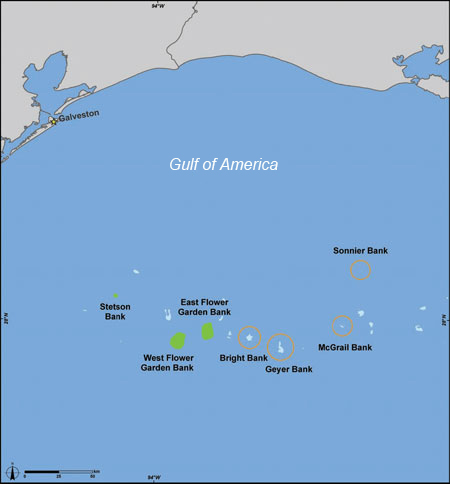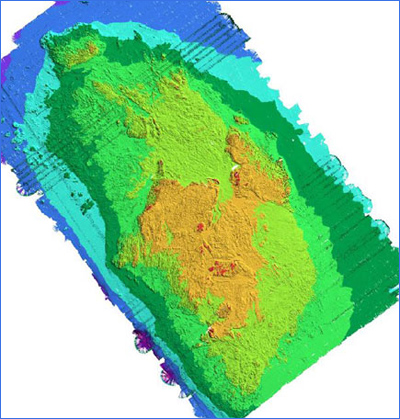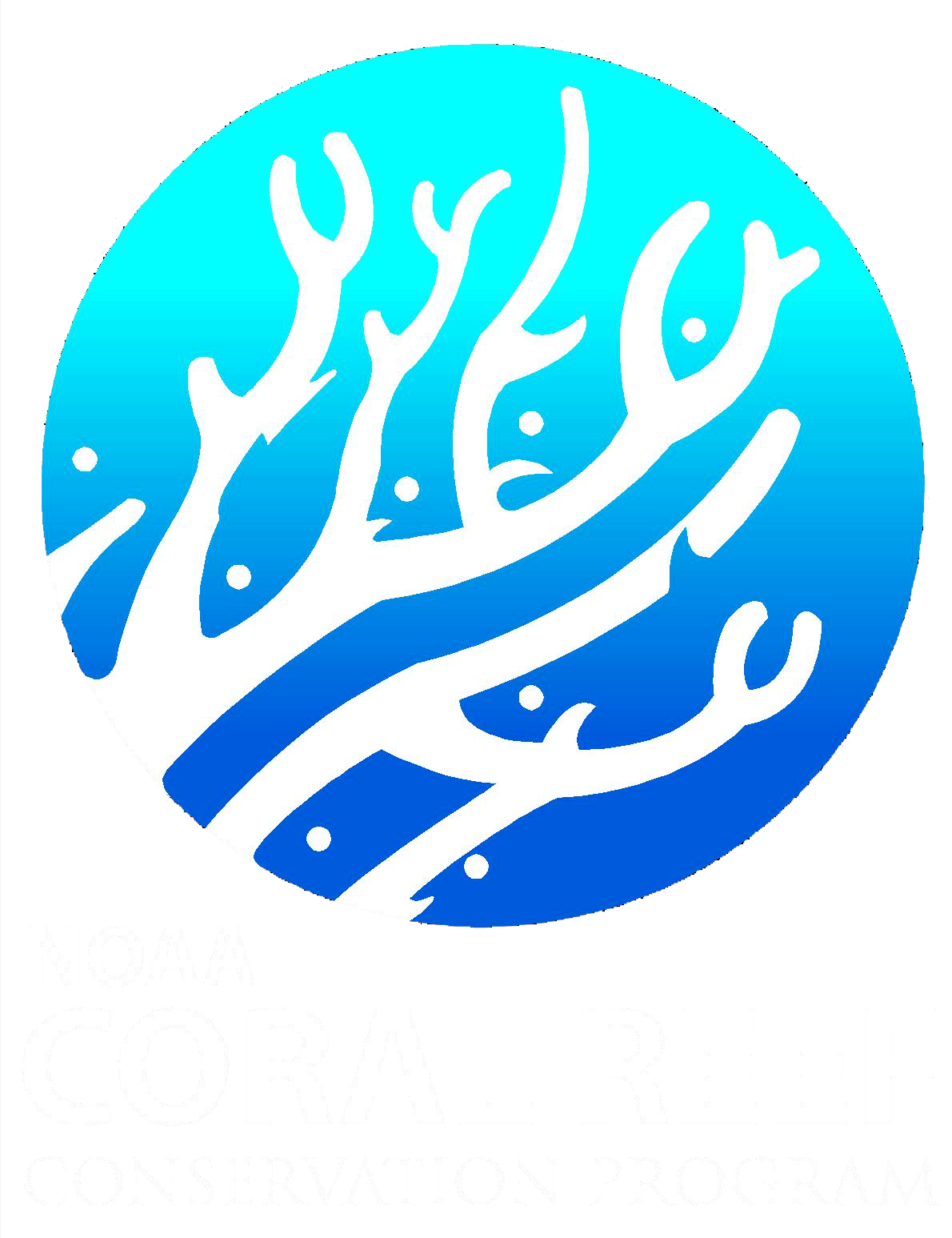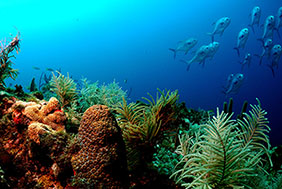-
Home
-
Data & Publications
-
Regional Portals
- About Regional Portals
- Florida
- Navassa Island
- Puerto Rico
- Flower Garden Banks
- U.S. Virgin Islands
- American Samoa
- Commonwealth of the Northern Mariana Islands
- Federated States of Micronesia
- Guam
- Main Hawaiian Islands
- Republic of the Marshall Islands
- Northwestern Hawaiian Islands
- Republic of Palau
- Pacific Remote Island Areas
-
CRCP Activities
- Glossary
Flower Garden Banks
East and West Flower Garden Banks were designated as the Flower Garden Banks National Marine Sanctuary (FGBNMS) through the National Oceanic and Atmospheric Administration (NOAA) in January 1992. In 1996, a third bank, Stetson Bank (not a true coral reef), was added to the Sanctuary. It is located about 30 miles northwest of the West Flower Garden Bank. Because of a number of factors, including geographical isolation and water temperature, there is a relatively low biodiversity of reef-building corals inhabiting these banks.
The Flower Garden Banks, which encompasses a variety of habitats, including the northernmost coral reefs in the continental United States, are located near the outer edge of the continental shelf in the northwestern Gulf of America (formerly Gulf of Mexico), approximately 120 miles southeast of Galveston, Texas. These banks, created by the uplift of underlying salt domes, rise from depths of over 330 feet to within 56 feet of the surface. They are relatively isolated from other Caribbean and Gulf of America coral reefs. The nearest reefs are 400 miles away in the Gulf of America off the coast of Tampico, and over 745 miles from the coral reefs of the Florida Keys.
The complexity of habitats supports a diverse assemblage of organisms including approximately 250 species of fishes, 23 species of coral, and 80 species of algae in addition to large sponge communities The predominant coral species at the East and West Flower Gardens are massive, closely-spaced boulder and brain corals and mountainous star corals. Coral growth is relatively uniform over the entire top of both banks, occupying the bank crests down to about 50 meters. The prevalent species at Stetson Bank are smaller encrusting corals, such as fire coral (not a true coral) and green cactus coral.
In addition to the coral reefs within the FGBNMS, there are a number of other reefs and banks in the northwestern Gulf of America that contain corals or coral communities. Some contain significant communities of deep water corals in depths from about 200 to 500 feet.
The coral reef ecosystem at the FGBNMS has been described as being relatively pristine and thriving, as compared to other Caribbean reef systems, despite its location in the middle of one of the largest oil and gas fields in the world.
Several reefs and banks in the vicinity of the FGBNMS also harbor deep water coral communities. These banks include Bright, Geyer, Sonnier, and McGrail Banks.

Flower Garden Banks location map

Flower Garden Banks satellite map
Publications
Flower Garden Banks National Marine Sanctuary - Document Library
2008 Condition Report for Flower Garden Banks National Marine Sanctuary
Guides
- Coral Cap Species List - comprehensive list of all the species identified in the sanctuary within recreational dive limits (0-130 ft, 0-40 m deep)
- Coral Guide - a picture guide to stony corals of the sanctuary within recreational dive limits (0-130 ft, 0-40 m deep)
FGBNMS Research Reports
- 2017 Research Report
- 2016 Research Report
- 2015 Research Report
- 2014 Research Report
- 2013 Research Report
- 2012 Research Report
- 2011 Research Report
- 2010 Research Report
- 2009 Research Report
- 2008 Research Report
- 2007 Research Report
- 2006 Research Report
- 2005 Research Report
- 2004 Research Report
- 2003 Research Report
- 2002 Research Report
BOEM (MMS) DOCUMENTS
- Long-Term Monitoring at the East and West Flower Garden Banks National Marine Sanctuary, 2009–2010; Volume 1: Technical Report
- Long-Term Monitoring at the East and West Flower Garden Banks National Marine Sanctuary, 2009–2010; Volume2: Appendices
- Long-Term Monitoring at the East and West Flower Garden Banks: 2004-2008, Volume I: Technical Report (2010-052)
- Long-Term Monitoring at the East and West Flower Garden Banks: 2004-2008, Volume II: Appendices (2010-053)
- Post-Hurricane Assessment of Sensitive Habitats of the Flower Garden Banks Vicinity (MMS 2009-032)
- Long Term Monitoring at the East and West Flower Garden Banks 2004-2005 - Interim Report Vol. I: Technical Report (MMS 2008-027)
- Long Term Monitoring at the East and West Flower Garden Banks 2004-2005 - Interim Report Vol. II: Appendices (MMS 2008-028)
- Post Hurricane Assessment at the East Flower Garden Bank Long Term Monitoring site: November 2005 (MMS 2008-019)
- Long Term Monitoring at the East and West Flower Garden Banks 2002-2003 (MMS 2006-035)
- Effect of Depth, Location, and Habitat Type, on Relative Abundance and Species Composition of Fishes Associated with Petroleum Platforms and Sonnier Bank in the Northern Gulf of America (MMS 2006-037)
- Long Term Monitoring at the East and West Flower Garden Banks 2000-2001 (MMS 2003-031)
- Long Term Monitoring at the East and West Flower Garden Banks 1998-1999 (MMS 2001-101)
Report on the Status of Marine Protected Areas in Coral Reef Ecosystems of the United States. Volume 1: Marine Protected Areas Managed by U.S. States,Territories, and Commonwealths. NOAA Technical Memorandum CRCP 2 February 2007
State of the Reefs Reports (SOTR)
The State of Coral Reef Ecosystems of the United States and Pacific Freely Associated States: 2008.
The State of Coral Reef Ecosystems of the United States and Pacific Freely Associated States: 2005.
The State of Coral Reef Ecosystems of the United States and Pacific Freely Associated States: 2002.
Metadata, Data and Publications Search in CoRIS
Search the CoRIS Geoportal for Flower Garden Banks metadata, data and publications
Near-Real-Time Data
Coral Reef Watch Satellite Monitoring
Coral Reef Watch - Greater Caribbean Virtual Stations
The Global Temperature-Salinity Profile Program
USGS Water Resources - Data for Texas
NOAA CO-OPS Water Level Data - Texas
NOAA CO-OPS Tide Predictions - Texas
National Data Buoy Center
Texas Automated Buoy System (TABS). Texas A & M University’s Geochemical and Environmental Research Group (GERG) operates two data buoys near the Flower Garden Banks National Marine Sanctuary at Sites N and V. The buoys measure winds, air temperature and humidity, atmospheric pressure, conductivity, and surface currents and report the data in near real time through the Texas Automated Buoy System.
http://tabs.gerg.tamu.edu/Tglo/
Other Data
Flower Garden Banks - GIS Mapping Tool
Education and Outreach
NOAA's Flower Garden Banks National Marine Sanctuary - Facebook Page
Flower Garden Banks National Marine Sanctuary - News and Events
Flower Garden Banks National Marine Sanctuary - Education
Flower Garden Banks National Marine Sanctuary - Research and Monitoring Summaries
- Algae and Invertebrates of Deepwater Communities in the Northwestern Gulf of America
- Antipatharians of Deepwater Communities in the Northwestern Gulf of America
- Fishes of Deepwater Communities in the Northwestern Gulf of America
- Octocorals of Deepwater Communities in the Northwestern Gulf of America
- Sponges of Deepwater Communities in the Northwestern Gulf of America
Marine Protected Areas/Marine Managed Areas
Marine Protected Areas of the United States Home Page
The Marine Protected Areas Inventory
Marine Federal Areas Fact Sheet
Executive order 13158: Marine Protected Areas
National Marine Sanctuaries Act
Flower Gardens Bank National Marine Sanctuary


